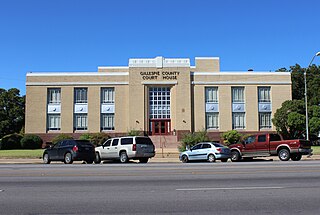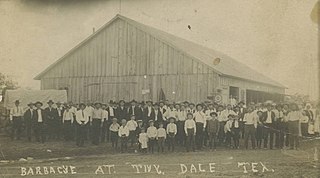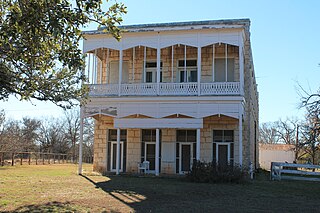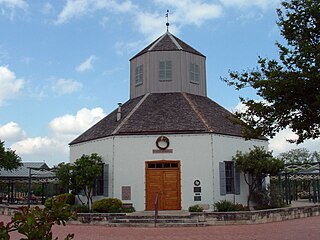
Hudspeth County is a county located in the U.S. state of Texas. As of the 2020 census, the population was 3,202. Its county seat is Sierra Blanca, and the largest community is Fort Hancock. The county is named for Claude Benton Hudspeth, a state senator and United States Representative from El Paso. It is northeast of the Mexico–U.S. border.

Gillespie County is a county located on the Edwards Plateau in the U.S. state of Texas. As of the 2020 census, its population was 26,725. The county seat is Fredericksburg. It is located in the heart of the rural Texas Hill Country in Central Texas. Gillespie is named for Robert Addison Gillespie, a soldier in the Mexican–American War.

Fredericksburg is a city in and the seat of Gillespie County, Texas, United States. As of the 2010 Census, this city had a population of 10,530.

Lyman Wight was an early leader in the Latter Day Saint movement. He was the leader of the Latter Day Saints in Daviess County, Missouri, in 1838. In 1841, he was ordained a member of the Quorum of the Twelve Apostles. After the death of Joseph Smith resulted in a succession crisis, Wight led his own break-off group of Latter Day Saints to Texas, where they created a settlement. While in Texas, Wight broke with the main body of the group led by Brigham Young. Wight was ordained president of his own church, but he later sided with the claims of William Smith, and eventually of Joseph Smith III. After his death, most of the "Wightites" joined with the Reorganized Church of Jesus Christ of Latter Day Saints.
Castell is a small unincorporated, rural town in Llano County, Texas, United States. It is part of the Texas German belt region, and most residents are still ethnic German-Texan. Its population was 104 at the 2010 census. Located in the heart of the Texas Hill Country, its northern border is formed by the Llano River. It was designated a Recorded Texas Historic Landmark in 1964, marker number 9440.

Cherry Spring is an unincorporated farming and ranching community established in 1852 in Gillespie County, in the U.S. state of Texas. It is located on Cherry Spring Creek, which runs from north of Fredericksburg to Llano. The creek was also sometimes known as Cherry Springs Creek by residents. The community is located on the old Pinta Trail. The Cherry Spring School was added to the National Register of Historic Places Listings in Gillespie County, Texas on May 6, 2005. The school was designated a Recorded Texas Historic Landmark in 1985.

Crabapple is an unincorporated farming and ranching community 10.5 miles (16.9 km) north of Fredericksburg in Gillespie County, Texas, United States, located on Crabapple Creek, about halfway between Fredericksburg and Enchanted Rock State Park at an elevation of 1,775 feet. Crabapple School was designated a Recorded Texas Historic Landmark in 1994, and added to the National Register of Historic Places in Texas on May 6, 2005.
Wilhelm Victor Keidel was the first medical doctor and first Chief Justice in Gillespie County, Texas. He was a veteran of the Mexican–American War. Keidel founded the settlement of Pedernales.
Grapetown is an unincorporated farming and ranching community 9.5 miles (15.3 km) south of Fredericksburg, situated on South Grape Creek in Gillespie County, in the U.S. state of Texas. It is located on the old Pinta Trail. Grapetown is noted for being the site of the first annual Gillespie County Bundes Schützenfest. The school was designated a Recorded Texas Historic Landmark in 1984, Marker number 10048.
Pedernales was an early settlement of German immigrants in Gillespie County, Texas, United States, and was part of the Adelsverein colonization of Texas. No trace of the settlement remains today. It was located 7 miles (11 km) southwest of Fredericksburg near what is now Texas State Highway 16. The Pedernales school received a Texas Historical Commission Subject Marker in 1993, Marker number 10095.

Tivydale is an unincorporated farming and ranching community located in Gillespie County, Texas, United States, located 14 miles (23 km) west of Fredericksburg, and was originally known as Bunkesville and Pumpkinville.
Jacob Kuechler (1823–1893) was surveyor, conscientious objector during the Civil War, and commissioner of the Texas General Land Office. Kuechler pioneered the science of dendrochronology to date natural events.

Friedrich Richard Petri (1824–1857) was a Kingdom of Saxony-born Texas painter whose works recorded life in the original German immigrant settlements, and portrayed Native American tribes in family settings.

Morris Ranch is a ghost town, located 8.5 miles (13.7 km) southwest of Fredericksburg in Gillespie County, in the U.S. state of Texas. The area was begun as a thoroughbred horse ranch by New Yorker Francis Morris in 1856, and the town grew up around it. In 1962, the school district was merged with Fredericksburg Independent School District, and the Morris Ranch school ceased operations. The Morris Ranch school was designated a Recorded Texas Historic Landmark in 1980, Marker number 10086. The school was added to the National Register of Historic Places listings in Texas, on March 29, 1983, NRHP Reference #:83003142.

Rheingold School is located at 334 Rheingold School Road, in Gillespie County, Texas. In 1949, the school was consolidated with Fredericksburg Independent School District. The building is now used as a community center. It was added to the National Register of Historic Places in Texas on May 6, 2005.
Cain City is a ghost town founded in 1915, 4 miles (6.4 km) southeast of Fredericksburg in Gillespie County, in the U.S. state of Texas. It was established to be a station stop of the Fredericksburg and Northern Railway Company, of which the city's namesake Charlie Cain was a leading fundraiser. The town suffered an economic downturn within a decade of being founded.
Eckert is a ghost town, 11.5 miles (18.5 km) northeast of Fredericksburg in Gillespie County, in the U.S. state of Texas. West of Willow City, on FM 1323, Eckert is at the junction of State Highway 16.
Mormon Mill is a vanished Mormon colony established in 1851 on Hamilton Creek in Burnet County, in the U.S. state of Texas. The site is located on Mormon Mills Road 5 miles (8.0 km) north of Marble Falls and 10 miles (16 km) south of Burnet. Mormon Mill has also been known as Mormon Mills, Mormon Mill Colony and Mormon Mill Historical Site. Designated a Recorded Texas Historic Landmark in 1936, Marker number 9733. The population moved to another county in 1853, and no buildings remain of the colony.

The History of Fredericksburg, Texas dates back to its founding in 1846. It was named after Prince Frederick of Prussia. Fredericksburg is also notable as the home of Texas German, a dialect spoken by the first generations of German settlers who initially refused to learn English. Fredericksburg shares many cultural characteristics with New Braunfels, which had been established by Prince Carl of Solms-Braunfels the previous year.
Robert Addison Gillespie (1815–1846) was a business man, land speculator, and Captain in the Texas Rangers under John Coffee Hays and Zachary Taylor. Gillespie died in the Battle of Monterrey. Gillespie County, Texas, was named in his honor.













